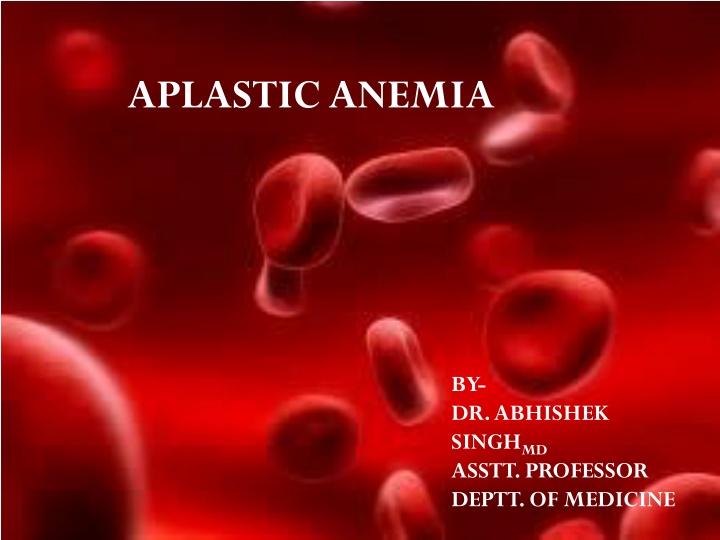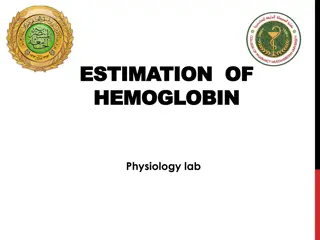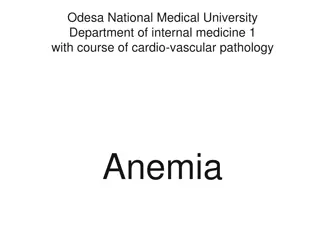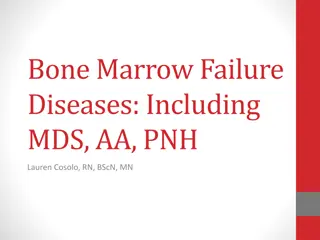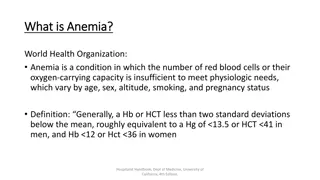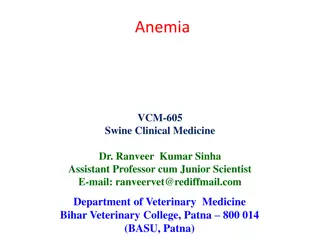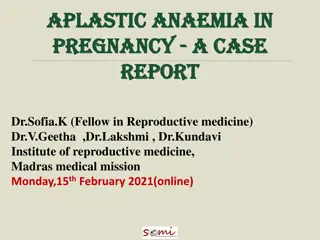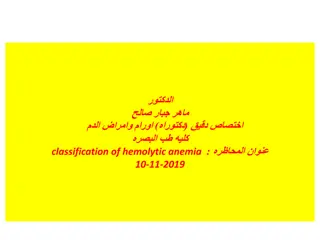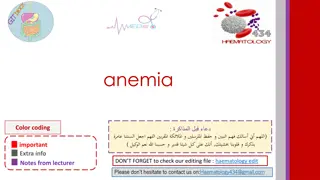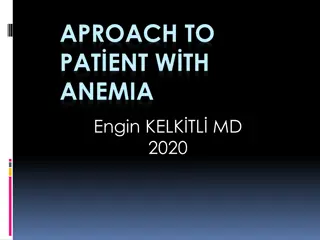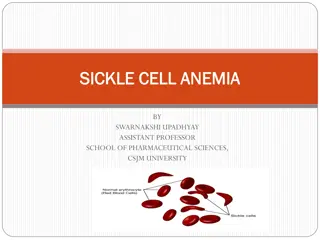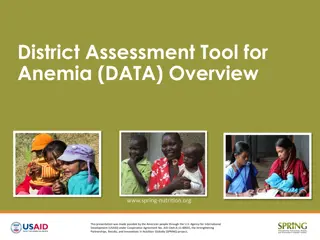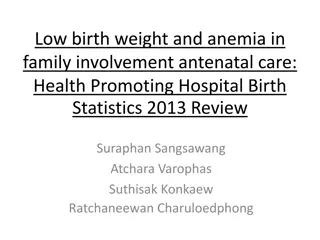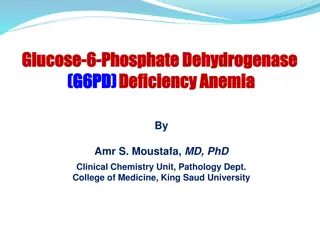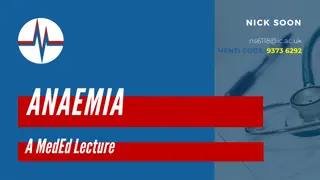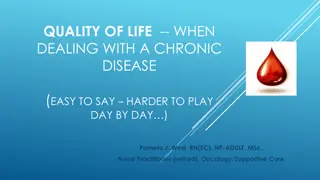APLASTIC ANEMIA
Aplastic anemia is characterized by bone marrow hypocellularity, affecting both genders equally. It can be inherited or acquired through factors like radiation, drugs, infections, and Fanconi's anemia. Management includes identifying causes and appropriate treatment options.
Download Presentation

Please find below an Image/Link to download the presentation.
The content on the website is provided AS IS for your information and personal use only. It may not be sold, licensed, or shared on other websites without obtaining consent from the author.If you encounter any issues during the download, it is possible that the publisher has removed the file from their server.
You are allowed to download the files provided on this website for personal or commercial use, subject to the condition that they are used lawfully. All files are the property of their respective owners.
The content on the website is provided AS IS for your information and personal use only. It may not be sold, licensed, or shared on other websites without obtaining consent from the author.
E N D
Presentation Transcript
APLASTIC ANEMIA BY- DR. ABHISHEK SINGHMD ASSTT. PROFESSOR DEPTT. OF MEDICINE
INTRODUCTION Aplastic anemia is pancytopenia with bone marrow hypocellularity. Men and women are affected with equal frequency. Age distribution is biphasic, with the major peak in the teens and twenties and a second rise in older adults.
CAUSES INHERITED- Fanconi's anemia Dyskeratosis congenita Shwachman-Diamond syndrome Reticular dysgenesis Amegakaryocytic thrombocytopenia Familial aplastic anemias Preleukemia (monosomy 7, etc.) Nonhematologic syndrome (Down, Dubowitz, Seckel)
CAUSES ACQUIRED- Radiation Drugs and chemicals Viruses (non-A, non-B, non-C Hepatitis, EBV, Parvovirus B19, HIV-1) Immune diseases (Eosinophilic fasciitis, Thymoma, Hyperimmunoglobulinemia, Graft-versus-host disease) Paroxysmal nocturnal hemoglobinuria, Pregnancy Idiopathic
RADIATION Marrow aplasia can be an acute sequale to radiation. Nuclear accidents power plant workers, employees of hospitals, laboratories, and industry (food sterilization, metal radiography) are susceptible to it. MDS and leukemia, but probably not aplastic anemia, are late effects of radiation. CHEMICALS Benzene
DRUGS- Agents that regularly produce marrow depression as major toxicity in commonly employed doses or normal exposures: Cytotoxic drugs (alkylating agents, antimetabolites, antimitotics), some antibiotics. Agents that frequently but not inevitably produce marrow aplasia: Benzene Agents associated with aplastic anemia but with a relatively low probability: Chloramphenicol, Anticonvulsants etc.
INFECTIONS- Hepatitis (non-A, non-B, non-C) is the most common preceding infection. Infectious mononucleosis & parvo virus B19 in some cases Rarely other bacterial & viral infections
FANCONIs ANEMIA- Autosomal recessive disorder Chromosomes in Fanconi's anemia are peculiarly susceptible to DNA cross-linking agent The most common, type A Fanconi's anemia, is due to a mutation in FANCA. manifests as congenital developmental anomalies (short stature, caf au lait spots, and anomalies involving the thumb, radius, and genitourinary tract), progressive pancytopenia, and an increased risk of malignancy
DYSKERATOSIS CONGENITA- X- linked, in some cases autosomal dominant mutations in genes of the telomere repair complex Characterized by Mucous membrane leukoplasia, dystrophic nails, reticular hyperpigmentation, and the development of aplastic anemia in childhood. SHWACHMAN- DIAMOND SYNDRME- compound heterozygous mutations in SBDS Marrow failure + Pancreatic insufficiency and malabsorption.
PATHOPHYSIOLOGY Bone marrow failure results from severe damage to the hematopoietic cell compartment. There is replacement of the bone marrow by fat. An intrinsic stem cell defect exists for the constitutional aplastic anemias Extrinsic damage to the marrow follows massive physical or chemical insults such as high doses of radiation and toxic chemicals Immune mediators like Helper T cells, TNF, IFN- may be involved in the pathogenesis.
CLINICAL PRESENTATION can appear seeming abruptly or have a more insidious onset. Bleeding is the most common early symptom. Easy bruising, oozing from the gums, epistaxis, heavy menstrual flow, and sometimes petechie (massive hemorrhage is unusual) Symptoms of anemia are also frequent, including lassitude, weakness, shortness of breath, and a pounding sensation in the ears. Infection (due to leukopenia) is an unusual first symptom in aplastic anemia.
CLINICAL EXAMINATION Petechiae and ecchymoses Pallor Retinal hemorrhage Look for other features associated with inherited causes Lymphadenopathy and splenomegaly are highly atypical of aplastic anemia.
INVESTIGATIONS BLOOD- Smear shows large erythrocytes and a paucity of platelets and granulocytes. Reticulocytes are absent or few. BONE MARROW- fatty biopsy specimen may be grossly pale Dilute smear Dry tap" instead suggests fibrosis or myelophthisis
TREATMENT Hematopoietic growth factors Immunosuppression Stem cell transplantation Supplementation of blood products and supportive care
Hematopoietic growth factors- Limited usefulness Stem cell transplantation- This is the best therapy for the younger patient with a fully histocompatible sibling donor. For allogeneic transplant from fully matched siblings, long-term survival rates for children are approximately 90%.
Immunosuppression- As most of patients lack suitable donor, it is the treatment of choice for them. ATG + Cyclosporine induces hematologic recovery in 60 % of cases. Relapse is frequent, usually after withdrawl of cyclosporine. MDS may develop in 15% of treated patients.
Increasing age and the severity of neutropenia are the most important factors weighing in the decision between transplant and immunosuppression in adults who have a matched family donor. Older patients do better with ATG and cyclosporine, whereas transplant is preferred if granulocytopenia is profound.
